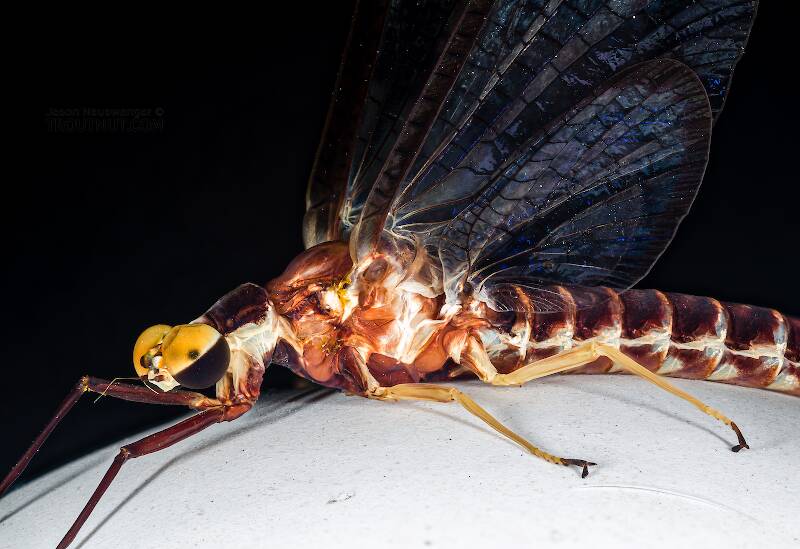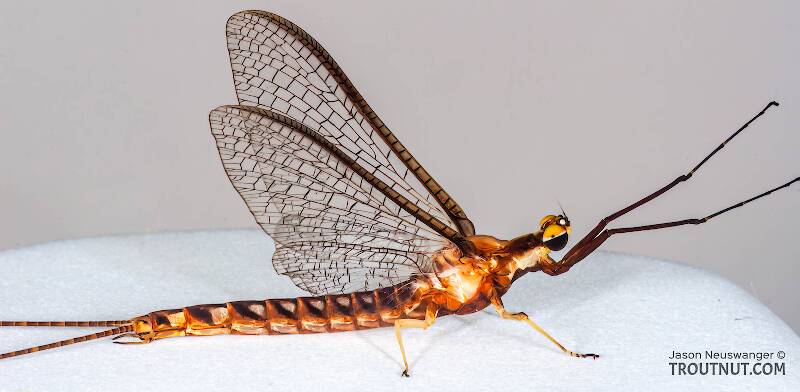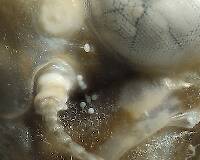
Hex Mayflies
Hexagenia limbata
The famous nocturnal Hex hatch of the Midwest (and a few other lucky locations) stirs to the surface mythically large brown trout that only touch streamers for the rest of the year.
Featured on the forum

Troutnut is a project started in 2003 by salmonid ecologist Jason "Troutnut" Neuswanger to help anglers and
fly tyers unabashedly embrace the entomological side of the sport. Learn more about Troutnut or
support the project for an enhanced experience here.
This topic is about the Mayfly Species Hexagenia limbata
It starts like a rise of small trout. There are dimples on the surface--fingerling trout eating midges, perhaps. But these are no fish. The water breaks and out pop the yellow sails of a giant Hexagenia dun. Then another. And another. A vortex appears in a flash below the mayfly and it vanishes with a slurp so loud it echoes off the distant bank. A square tail like a shark fin breaks the surface behind the swirl as a brown trout twice the size of your net retreats back to his deeper lair. The Hex hatch is on.This Midwestern legend plays out every year on calm, dark, humid nights in early July. Anglers who only fly fish once a year drive hundreds of miles to play their part in the drama, while the mayflies themselves make the television news by showing up on doppler radar or calling snowplows out of dormancy to remove layers of Hexagenia (or "Hex") duns from the bridges. In the cold trout rivers of Wisconsin and Michigan, huge nocturnal brown trout whose usual menu consists of smaller brown trout become, for a week or so, prime dry fly quarry.
According to the literature, these are the second largest mayflies in the United States, behind the related Litobrancha recurvata flies. However, there are reports of limbata exceeding 40mm in some locales, which would make them the largest.
Example specimens
Teacherprea on Jun 2, 2007June 2nd, 2007, 10:16 am EDT
I am a fly fisherman but not a "purist". A friend of mine has a place on the UP of Michigan. He just called me and said a guy told him there is a way to preserve "wigglers." They use them alot up north, those that are not fly fishermen or ladies. They are fishing perch, bluegill and crappie. He heard there is a way to "blanch" them.Drop them in hot water for a few minutes and they turn rubbery. They then will keep indefinitely. Has anyone heard of this? If so, how close to correct is the procedure I mentioned??
Thanks for anyone's help.
Thanks for anyone's help.
Dick Gross
Hobart, IN
Hobart, IN
Troutnut on Jun 2, 2007June 2nd, 2007, 10:32 am EDT
I don't really know how to do that, but if you do, be sure it's still legal there. It's illegal to do that in Wisconsin, New York, and many other states.
Jason Neuswanger, Ph.D.
Troutnut and salmonid ecologist
Troutnut and salmonid ecologist
Shawnny3 on Jun 2, 2007June 2nd, 2007, 1:36 pm EDT
Teacherprea -
Could you clarify for me what a wiggler is? I've never heard of it.
Thanks,
Shawn
Could you clarify for me what a wiggler is? I've never heard of it.
Thanks,
Shawn
Jewelry-Quality Artistic Salmon Flies, by Shawn Davis
www.davisflydesigns.com
www.davisflydesigns.com
Teacherprea on Jun 2, 2007June 2nd, 2007, 2:10 pm EDT
Wiggler's are the larvae of the may fly.
Dick Gross
Hobart, IN
Hobart, IN
Teacherprea on Jun 2, 2007June 2nd, 2007, 2:11 pm EDT
Troutnut, thanks for the heads up on the legality point. I'll tell my buddie.
Dick Gross
Hobart, IN
Hobart, IN
Konchu on Jun 2, 2007June 2nd, 2007, 3:28 pm EDT
I've only heard of mosquito larvae being called wigglers. Are these mayflies the big, burrowing kind of larva?
Troutnut on Jun 2, 2007June 2nd, 2007, 3:51 pm EDT
The "Michigan wiggler" is a common name, specifically, for the huge burrowing mayfly larvae of Hexagenia limbata. I've got quite a few good pictures of one.
Jason Neuswanger, Ph.D.
Troutnut and salmonid ecologist
Troutnut and salmonid ecologist
Taxon on Jun 2, 2007June 2nd, 2007, 3:55 pm EDT
Teacherprea on Jun 3, 2007June 3rd, 2007, 1:50 am EDT
Troutnut, and what might be the ruling about preserving "wigglers" that would make it illegal?
Dick Gross
Hobart, IN
Hobart, IN
Troutnut on Jun 3, 2007June 3rd, 2007, 3:04 am EDT
The law isn't really against "preserving" them. At least in Wisconsin, it's illegal to remove them from the stream for use as bait. You can go to the stream and catch some and use them for bait then and there, but you have to release the unused ones before you leave. Catching a bunch to preserve and use later would be illegal under this law, too.
The main reason behind the law, I think, is to prevent bait shops and avid ice fishermen from decimating a trout stream's insect population by dredging too much of the bottom for bait. It may also be motivated by the desire to keep people from introducing insect species where they aren't native, or moving any diseases they may carry from one watershed to another.
Again, I don't have any idea if Michigan has a statute about this or not. But you should check the regulations carefully before doing it.
The main reason behind the law, I think, is to prevent bait shops and avid ice fishermen from decimating a trout stream's insect population by dredging too much of the bottom for bait. It may also be motivated by the desire to keep people from introducing insect species where they aren't native, or moving any diseases they may carry from one watershed to another.
Again, I don't have any idea if Michigan has a statute about this or not. But you should check the regulations carefully before doing it.
Jason Neuswanger, Ph.D.
Troutnut and salmonid ecologist
Troutnut and salmonid ecologist
Hendrickson
Posts: 2
Posts: 2
Hendrickson on Jun 3, 2007June 3rd, 2007, 3:04 am EDT
You have to have permit to harvest hexes in Michigan and to blanch them. If you sell them, you need a commerical harvesting permit.People do it, but it's not legal to do so..... Wisconsin is much the same....there's a limit of up to $500.00 before you need a dealer's license and that has more to do with sales tax issues and spreading things like VHS....
Nightfisher
Posts: 7
Posts: 7
Nightfisher on Jun 14, 2007June 14th, 2007, 7:46 am EDT
I dont know about using them for bait. but I preserved one in a specimen bottle several years ago and I am still carying it around in my fly tying kit. The secret juice that preserved it: Absolute vodka which, for some reason, I happened to have on hand at the time.
Steelhead30 on Apr 7, 2009April 7th, 2009, 5:42 am EDT
I have been perserving wigglers for along time and they work like magic,they dont lose any color,and they stay on the hook better than if they were alive.
LittleJ on Apr 7, 2009April 7th, 2009, 6:13 am EDT
for god sakes, wigglers...hairy honey bugs..... shawn's curly worm. I think I'm going to have to take a break from this site:)
Mario on May 1, 2009May 1st, 2009, 11:47 am EDT
I would love to be able to catch a few wigglers and preseve them does anyone know the technique of catching and then how do you preserve them?? Won't need many but would be nice to have for herring fishing. thanks mario
Bubba50 on Feb 25, 2011February 25th, 2011, 1:12 pm EST
How do i go about buying some Michigan wigglers, I love using them for pan fish and I cant find any around where I live now
Fishead
Posts: 1
Posts: 1
Fishead on Apr 25, 2014April 25th, 2014, 4:05 pm EDT
Preserving wigglers is easy. Bring 2 cups water to a boil, reduce to a simmer, add 1/4 cup borax, dissolve add wigglers simmer for two minutes. Place on paper towel, pat dry and let cool. Done! Harvesting to take home is illegal without a license in Michigan, but you can buy them in any bait shop, at least in northern Michigan, I'm not sure about down in the city. I don't go there.
Wbranch on Apr 26, 2014April 26th, 2014, 7:05 am EDT
Oh oh, so your a scent dipper! Do you also tip your nymphs with the "real thing" when the going gets tough? I for one am shocked and appalled.
Catskill fly fisher for fifty-five years.
Wbranch on Apr 26, 2014April 26th, 2014, 4:52 pm EDT
Mack,
I wrote;
I hope you know I was just kidding you. My sense of humor can be too droll. My wife always tells me not to tease people who I don't know all that well. Beleive it or not I don't use a fly rod 100% of the time. From early September to late October I'm often found in my bass boat anchored in some soft water adjacent to a riff with one spin rod out with a 4" live shiner and the other rod I'm throwing a 4" - 5" Gulp minnow. I like to fish live shiners it reminds me of when I was a kid out with my Dad. I still get a thrill when I feel the tap, tap, as the bass starts to take the minnow.
I wrote;
I for one am shocked and appalled.
I hope you know I was just kidding you. My sense of humor can be too droll. My wife always tells me not to tease people who I don't know all that well. Beleive it or not I don't use a fly rod 100% of the time. From early September to late October I'm often found in my bass boat anchored in some soft water adjacent to a riff with one spin rod out with a 4" live shiner and the other rod I'm throwing a 4" - 5" Gulp minnow. I like to fish live shiners it reminds me of when I was a kid out with my Dad. I still get a thrill when I feel the tap, tap, as the bass starts to take the minnow.
Catskill fly fisher for fifty-five years.
Oldredbarn on Apr 27, 2014April 27th, 2014, 8:05 pm EDT
Me thinks we should of left this post to die way back in 2007. :)
We here in Michigan have a special relationship with Hexagenia as does our fish.
The Hex 'nymphs" are used often as bait when ice fishing. Especially when perch are involved. If you have ever held one out of the water in your hand you would understand the "wiggler" handle. They wiggle so hard it feels like they have serious muscles. Once they are dropped back in the water they drop to the bottom and disappear within seconds back into the silt.
Mack...There are flies designed to replicate the Hex nymph, though most of them appear more like dragonfly nymphs to me than the Hex. The live ones with their undulating gills, the ones used as bait, look rather delicate and that undulation, though many attempts have been made to copy it, Mother Nature beats us hands down.
Way back to Swisher-Richard's books in the 70's they had a "wiggle-nymph" that was hinged...An early articulated pattern to try to copy the wiggling of the bug.
Yes you need to have a permit of sorts to harvest them. I have found what I took to be both age classes in the same silt...The mature one is one size and the end of the first year one is half its size. For many years, on my favorite small-mouth stream, there is a group of anglers that harvest hellgrammites that they then use as bait.
When the big lake Hex hatch the fishing can come to a screeching halt. The fish, perch, walleye, etc gorge on them until they look like footballs or stuffed sausage...and they spit them up when you pull them up out of the water.
As bait they are not always easy to find, but most communities with a connection to ice fishing on the lakes both great and inland, have a long standing tradition with using them as bait.
It really blows my mind every time I see the Hex hatch. It is beyond belief sometimes the amount of protein a good clean stream can produce. There are car accidents on the upper east side along lake St Clair where the hatched duns are preparing for their final molt and are tracked to street lights etc. When the spinners are in the air you can hear them flying around, and they have even been picked up on doppler radar.
Normally sulking Browns lose all their senses and feed like pigs. The whole river percolating ...You can almost walk up to them and tap them on their heads with the tip of your rod.
My favorite was at a place that is known as Daisy Bend on the S Branch of the Au Sable...I was fishing during the day near Father's Day and there was nothing what-so-ever going on...All of a sudden a nice fish charged the surface and jumped crazily around a couple times...I then saw this fish banging its nose into the silt banks trying to dislodge Hex nymphs...A large silt stream was floating downstream below it...
It had lost its mind.
Spence
We here in Michigan have a special relationship with Hexagenia as does our fish.
The Hex 'nymphs" are used often as bait when ice fishing. Especially when perch are involved. If you have ever held one out of the water in your hand you would understand the "wiggler" handle. They wiggle so hard it feels like they have serious muscles. Once they are dropped back in the water they drop to the bottom and disappear within seconds back into the silt.
Mack...There are flies designed to replicate the Hex nymph, though most of them appear more like dragonfly nymphs to me than the Hex. The live ones with their undulating gills, the ones used as bait, look rather delicate and that undulation, though many attempts have been made to copy it, Mother Nature beats us hands down.
Way back to Swisher-Richard's books in the 70's they had a "wiggle-nymph" that was hinged...An early articulated pattern to try to copy the wiggling of the bug.
Yes you need to have a permit of sorts to harvest them. I have found what I took to be both age classes in the same silt...The mature one is one size and the end of the first year one is half its size. For many years, on my favorite small-mouth stream, there is a group of anglers that harvest hellgrammites that they then use as bait.
When the big lake Hex hatch the fishing can come to a screeching halt. The fish, perch, walleye, etc gorge on them until they look like footballs or stuffed sausage...and they spit them up when you pull them up out of the water.
As bait they are not always easy to find, but most communities with a connection to ice fishing on the lakes both great and inland, have a long standing tradition with using them as bait.
It really blows my mind every time I see the Hex hatch. It is beyond belief sometimes the amount of protein a good clean stream can produce. There are car accidents on the upper east side along lake St Clair where the hatched duns are preparing for their final molt and are tracked to street lights etc. When the spinners are in the air you can hear them flying around, and they have even been picked up on doppler radar.
Normally sulking Browns lose all their senses and feed like pigs. The whole river percolating ...You can almost walk up to them and tap them on their heads with the tip of your rod.
My favorite was at a place that is known as Daisy Bend on the S Branch of the Au Sable...I was fishing during the day near Father's Day and there was nothing what-so-ever going on...All of a sudden a nice fish charged the surface and jumped crazily around a couple times...I then saw this fish banging its nose into the silt banks trying to dislodge Hex nymphs...A large silt stream was floating downstream below it...
It had lost its mind.
Spence
"Even when my best efforts fail it's a satisfying challenge, and that, after all, is the essence of fly fishing." -Chauncy Lively
"Envy not the man who lives beside the river, but the man the river flows through." Joseph T Heywood
"Envy not the man who lives beside the river, but the man the river flows through." Joseph T Heywood
Quick Reply
Related Discussions
Topic
Replies
Last Reply
8
Dec 10, 2009
by Jmd123
by Jmd123










